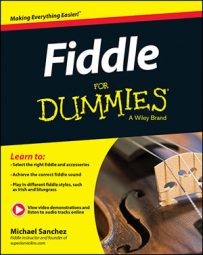Using the small muscles in your arm is important when you play the fiddle. Because you use your shoulders and big muscles for a lot of things, your instinct is to use them to extend your arm too. Unfortunately, doing so causes irritating sounds like bow squeaks (a most unpleasant sound!), bow bouncing, and other problems.
The following steps show you how to use your arm properly when bowing back and forth.
Put your bow at the contact point.
Place your elbow at the exact height of the fiddle and place your bow on the D string.
Extend your entire arm and move the bow about 1 inch from the contact point.
This is the only time you should move your entire arm in the bow stroke. After this you’ll keep your elbow and arm in the same position for the rest of the bow stroke.
Go all the way to the tip of the bow, but don’t use any of your upper arm to help extend your arm out.
You can watch your elbow to make sure it stays in the same place. There should be no shoulder or up-and-down elbow movement in this step — only forearm movement.
As you start to go back in the other direction from the tip of the bow, bend your wrist.
As you bend your wrist, you’ll be tempted to move your upper arm and shoulder as well. Don’t do this until you reach 1 inch from the contact point.
Use your elbow and upper arm to get back to the contact point.
To do another bow stroke, repeat from Step 3.
If you do Steps 4 and 5 incorrectly in this drill, you’ll have done what is sometimes called the gradual arm extension, which means extending and moving the arm at the same time. This promotes using the proper muscles instead of big muscles, causing bow bounce and crooked bow movement.
It’s important not to move your shoulder and upper arm at all after you get past the 1-inch point. Coming back the other way, don’t bend your wrist and move your arm at the same time. Remember, it’s all about the small muscles, so be very deliberate in doing all the preceding steps This feels weird, but don’t worry, you’ll get the hang of it with enough practice.
You should do a few arm extension drills on the fiddle to really make sure you’re doing the arm extension properly.
Your first option is a drill called the wall practice. Just follow these steps:
Put your bow at the contact point.
Put your elbow up against a wall at instrument height.
Keep your fiddle still and practice moving the bow back and forth.
Don’t move your elbow from this position. This helps you not to use your upper arm and shoulder when playing.
Another good drill for proper arm extension is called the armchair drill. Here’s how to do it:
Put your bow at the contact point.
Find an armchair or hard surface that you can put your elbow up against.
Keep your elbow in place and practice going all the way to the tip of the bow and back.
This drill helps you not to rely on your upper arm and shoulder to move the bow.
You should bow by moving your arm 1 inch when you’re going away from the contact point and 1 inch coming back to the contact point. Technically, the wrist drill doesn’t have you moving your arm in the stroke, but the arm extension drills do have you moving it 1 inch. The other drills are still very helpful to understand how you shouldn’t rely on your shoulder and upper arm to bow.

